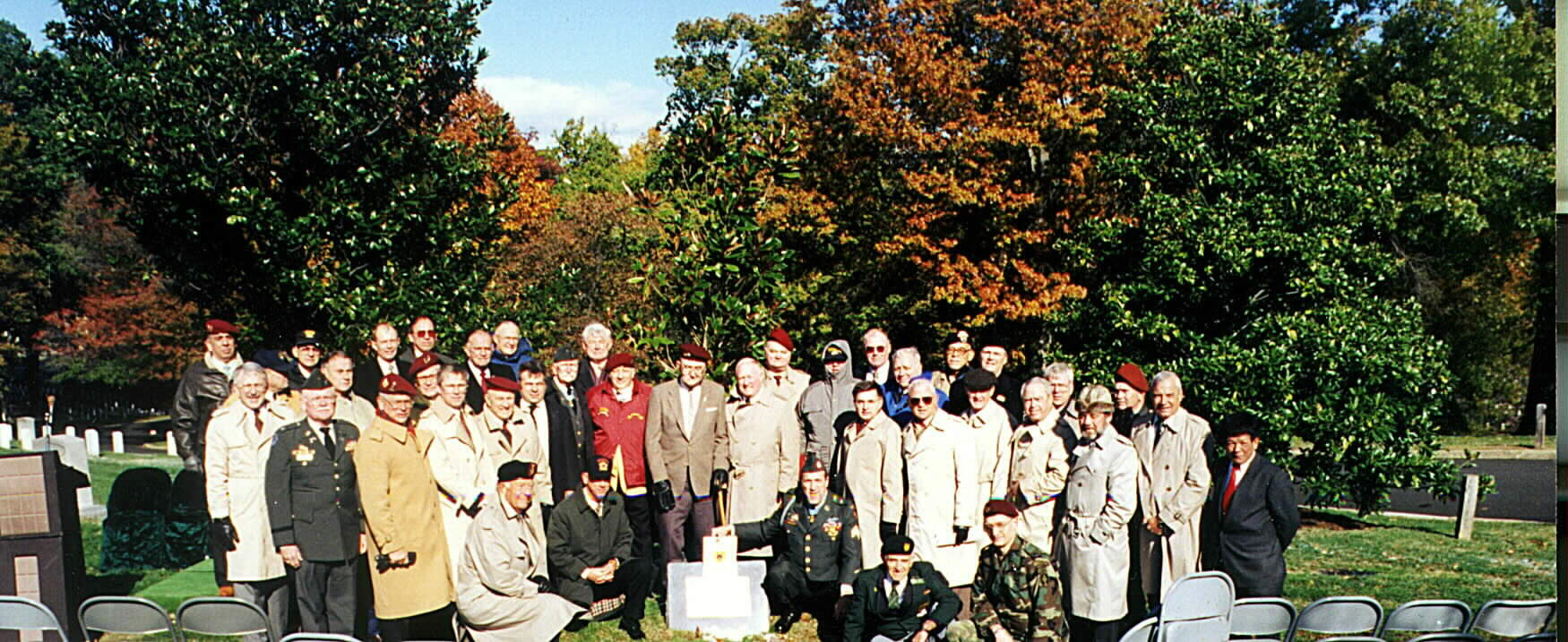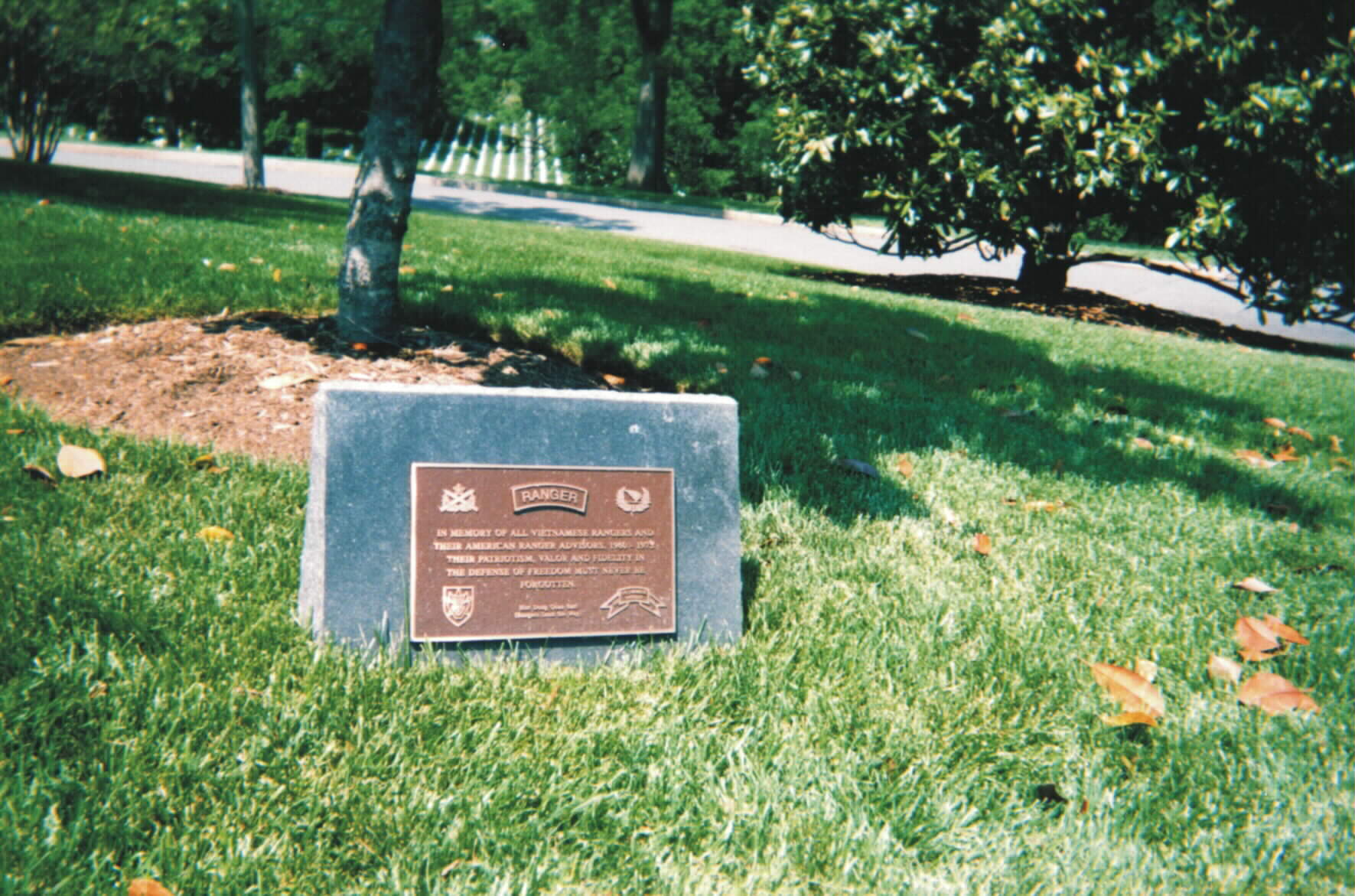Arlington National Cemetery Memorial
Vietnamese Rangers (Biet Dong Quan)
And Ranger Advisors
Vietnamese Ranger and Ranger Advisor History
Activated in 1960, Army of the Republic of Vietnam (ARVN) Rangers (Biet Dong Quan [BDQ]) initially organized into separate companies to counter the guerilla war being waged by the Viet Cong (VC). From the beginning, American Rangers were assigned as advisors, initially as members of the Mobile Training Teams (MTTs), deployed from the U.S., at training centers, and later at the unit level as members of the Military Advisory Command Vietnam (MACV). A small number of promising Vietnamese Ranger leaders were selected to attend the U.S. Army Ranger School at Ft. Benning. As a result of their common experiences, lasting bonds of mutual respect were formed between the combat veterans of both Nations.
In 1962, BDQ companies were grouped to form counter-guerilla Special Battalions. By 1963, the war had expanded as main force North Vietnamese Army (NVA) units began invading the South, launching battalion and regimental-size attacks against ARVN units. To cope with the escalation, Ranger units were organized into battalions and their mission evolved from counter-insurgency to light infantry operations. During 1966, the battalions were formed into task forces, and five Ranger Group headquarters were created at corps level to provide command and control for tactical operations. The Ranger Group structure was maintained until 1970 as U.S. force reduction commenced. The Civilian Irregular Defense Group (CIDG) situated along the Laotian and Cambodian borders, formerly under control of 5th U.S. Special Forces Group, was integrated into the Ranger command. Thus, the Rangers assumed an expanded role of border defense. The conversion of CIDG camps to combat battalions more than doubled the Ranger force size.
In the closing days of the war in 1975, Rangers fought to the end with most units totally destroyed. Many fought back independently, refusing to surrender. In Saigon, Rangers fought until the morning of 30 April when they were ordered to lay down their arms, as their country capitulated to the communists. Most of the Ranger leaders were considered too dangerous by the communist government and sentenced to long periods of incarceration in the dreaded “reeducation” camps.
The Role of the Advisor
The experiences of the American advisors (and a few Australians) to the BDQ were unique from other advisors and definitely different from their U.S. unit counterparts. Their mission and the force structure of the units they advised demanded more experienced and thoroughly trained individuals. Officers were almost all Ranger qualified, and after 1966 most were on a second or subsequent combat tour. The Non-Commissioned Officers were arguably the most talented Sergeants that the Army had to offer. Many of these Officers and Sergeants were experienced cadre from the Ranger Department at the Infantry School (subsequently the Ranger Training Brigade), or experienced small unit leaders with Infantry, Special Forces or Marine backgrounds; some had fought in World War II and/or Korea. According to the MACV joint manpower authorization documents, advisory teams were fairly robust — at least on paper. Each was authorized eight personnel to perform the support mission. This was usually not the case however. It was not uncommon to field teams of two or three personnel.
In addition to being selected for tactical and technical proficiency, many Ranger advisors were graduates of the Military Assistance and Training Advisory Course (MATA) and Vietnamese Language School. However, the tactical requirements always exceeded the number of school slots, and most advisors depended upon lessons learned the hard way, and the good luck to have a Vietnamese counterpart who understood English. Each team was authorized a local interpreter/translator, but these proved to be of varied skills and reliability.
Living and military operations experience for the Ranger advisor varied dramatically from area to area, unit to unit, and year to year. Operations were normally conducted by Ranger battalions, but were often smaller in some locales. Frequently, multi-battalion operations were conducted under the command and control of the Ranger Group headquarters.
The primary mission of an advisor was to counsel his Vietnamese counterpart on development and implementation of operational plans as well as the tactical execution of military operations. The advisor coordinated any available combat support from U.S. forces such as artillery, armored vehicles, air strikes, helicopter gun ships, naval gunfire, and medical evacuation. Additionally, the advisor was expected to escort and directly communicate with a variety of specialist teams that might accompany the unit on operations, such as artillery forward observers, Air Force forward air controllers (FAC), naval gunfire teams, canine handlers, or combat correspondents.
While differences were evident from team to team, the Ranger advisors led a unique life under an unusual set of circumstances. The highly mobile advisory team was with the Vietnamese unit at all times when it was in the field on military operations, which could last for days or weeks. Living conditions were Spartan and arduous. Frequent and intense combat was the rule for Ranger units. The team survived on limited supplies and rations (resupply in the field was sporadic at best), often with a limited knowledge of the operational plan and enemy intelligence situation. The team’s communications lifeline and link were often a single PRC-25 tactical radio. Despite, or because of these circumstances and conditions, the Ranger advisors became very adept at accomplishing their responsibilities and fulfilling their missions.
Awards and Honors
Vietnamese Ranger units and individual soldiers received a wide range of awards for valor and heroism from both the Republic of Vietnam and the United States. Eleven U.S. Presidential Unit Citations were awarded to Vietnamese Ranger units. The U.S. Valorous Unit Award was awarded to six Ranger battalions. Large numbers of individual Vietnamese Rangers were presented U.S. awards including the Silver Star, Bronze Star, and Army Commendation Medals for acts of valor in the face of enemy forces.
A number of American Ranger Advisors were decorated for gallantry under fire; the best known is SFC Gary Lattrell who was awarded the Medal of Honor for heroism as an advisor to the 23rd Ranger Battalion. Additionally, Colonel Lewis L. Millett, a Medal of Honor recipient during the Korean War, was a member of the first Vietnamese Ranger MTT. Staff Sergeant David Dolby, who was previously awarded the Medal of Honor while serving with the First Cavalry Division in 1965, was a Ranger advisor. Two Ranger advisors received the Medal of Honor on subsequent tours with U.S. units. More than two dozen Ranger advisors received the Army Distinguished Service Cross or the Navy Cross, the second highest valor award. Finally, nearly 50 American advisors were killed while fighting alongside their Vietnamese Ranger counterparts. Theirs was the ultimate sacrifice in the performance of their duty.
Living Memorial
On 12 November 1995, more than 20 years after the fall of Saigon, American Ranger advisors and their Vietnamese Ranger counterparts gathered at Arlington National Cemetery to unveil a living memorial and bronze plaque to honor their comrades. The living memorial, located on Farrigut Avenue, consists of an American Magnolia tree and a bronze plate that depicts a Ranger Tab and scroll; as well as a Vietnamese Ranger Badge and beret badge. The plaque reads, “Dedicated to the honor of the Vietnamese Rangers and their American Ranger advisors whose dedication, valor and fidelity in the defense of freedom must never be forgotten.”
Biet Dong Quan Sat!
Rangers Lead the Way!
Michael Robert Patterson was born in Arlington and is the son of a former officer of the US Army. So it was no wonder that sooner or later his interests drew him to American history and especially to American military history. Many of his articles can be found on renowned portals like the New York Times, Washingtonpost or Wikipedia.
Reviewed by: Michael Howard


